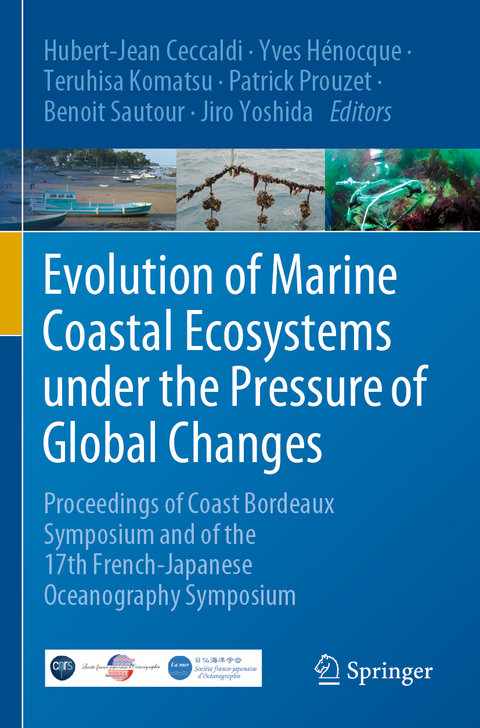
Evolution of Marine Coastal Ecosystems under the Pressure of Global Changes
Springer International Publishing (Verlag)
978-3-030-43486-1 (ISBN)
Part I: Introductory Communications.- Chapter 1. Our Future and The Oceans.- Chapter 2. General guidelines for future exchanges in marine science and technology between the two Sociétés franco-japonaises d'Océanographie.- Part II: Identification and Analysis of Environmental Stressors.- Chapter 3. The Japan Sea: a changing Pacific Asian marginal sea.- Chapter 4. Statistical analysis of surface circulation in Sagami Bay using High Frequency HF Radar.- Chapter 5. Statistical analysis of high frequency pCO2 data acquired with the Astan buoy (Southern Western English Channel, off Roscoff).- Chapter 6. Spatial variation in pCO2 based on 16 years of in-situ measurements in the Seto Inland Sea, Japan.- Chapter 7. The Bay of Seine: a resilient socio-eco-system under cumulative pressures.- Chapter 8. Effect of bacterial infection on the expression of stress proteins and antioxidative enzymes in Japanese flounder.- Part III: Impacts on Socio-Eco-Systems and Biological Resources.- Chapter 9. AReview of the Effects of Global Warming and Currents Trends on Fisheries and its Impact on Important Commercial Species in Japan.- Chapter 10. Physiology of winter coral bleaching in temperate zone.- Chapter 11. Preliminary report of impacts of the 2011 earthquake and tsunami and subsequent events on macrobenthic community in a shallow brackish lagoon in Sendai Bay, Japan.- Chapter 12. Post-tsunami oyster feeding environment in Nagatsuraura Bay for three years.- Chapter 13. Seagrass-oyster farmers interaction detected by eelgrass DNA analysis in Hinase area of the Seto Inland Sea, Japan.- Chapter 14. Fisheries Biology of Blue Sharks in Sagami Bay, Japan.- Part IV: Vulnerability of Coastal Ecosystems and Risk Assessment.- Chapter 15. Temperature and salinity changes in coastal waters of Western Europe: variability, trends and extreme events.- Chapter 16. Risk Based Consenting of Offshore Renewable Energy Projects (RICORE).- Chapter 17. Does global warming favour the occurrence of recent blue mussel mortality events in France?.- Chapter 18. Integrated ecosystem management for exploited coastal ecosystem dynamics under oligotrophication and climate changes.- Chapter 19. Forty years of decline and 10 years of management plan: are European eels (Anguilla anguilla) recovering?.- Chapter 20. The management of Mediterranean coastal habitats: a plea for a socio-ecosystem-based approach.
| Erscheinungsdatum | 18.06.2021 |
|---|---|
| Zusatzinfo | XXIX, 517 p. 248 illus., 194 illus. in color. |
| Verlagsort | Cham |
| Sprache | englisch |
| Maße | 155 x 235 mm |
| Gewicht | 831 g |
| Themenwelt | Naturwissenschaften ► Biologie ► Ökologie / Naturschutz |
| Naturwissenschaften ► Geowissenschaften ► Geografie / Kartografie | |
| Naturwissenschaften ► Geowissenschaften ► Hydrologie / Ozeanografie | |
| Schlagworte | Biological Resources • Coastal Ecosystems • Community Restoration Processes • Environmental stressors • integrated approaches |
| ISBN-10 | 3-030-43486-9 / 3030434869 |
| ISBN-13 | 978-3-030-43486-1 / 9783030434861 |
| Zustand | Neuware |
| Haben Sie eine Frage zum Produkt? |
aus dem Bereich


